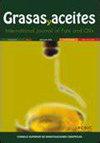Seasonal effect on fatty acid composition in phospholipid classes and triacylglycerols of male Capoeta umbla
IF 1.1
4区 农林科学
Q4 CHEMISTRY, APPLIED
引用次数: 0
Abstract
The seasonal changes in muscle tissue, total lipids and fatty acid composition of phospholipids (PL), triacylglycerol (TAG), and phospholipid classes of male Capoeta umbla were investigated in this study. Phosphatidylcholine (PC), phosphatidylethanolamine (PE), phosphatidylinositol (PI), and phosphatidylserine (PS) were identified as the major phospholipids (PLs) in the muscle tissue (PS). Triacylglycerols showed high contents of MUFA, 14:0, 16:1n-7, 18:1n-9, 18:2n-6, and 18:3n-3; while phospholipids presented high contents of AA, DHA, and 18:0. Myristic acid, 16:1n-7, 18:1n-9, monounsaturated fatty acids (MUFA), linoleic acid (18:2n-6), and linolenic acid (18:3n-3) were shown to be present in larger concentrations in TAG than in PL classes. In PL classes, 16:0, 18:0, arachidonic acid (20:4n-6) (AA), eicosapentaenoic acid (EPA) (20:5n-3), docosahexaenoic acid (DHA) (22:6n-3) and polyunsaturated fatty acid (ΣPUFA) were higher than the TAG fraction. The fatty acid composition of total lipid and lipid classes (TAG and PL) were affected by the seasonal variations and lipid fraction.季节对雄性黑衣磷脂类脂肪酸组成及甘油三酯的影响
本文研究了雄性黑斑卡波塔(Capoeta umbla)肌肉组织、磷脂(PL)、甘油三酯(TAG)和磷脂类的总脂和脂肪酸组成的季节变化。磷脂酰胆碱(PC)、磷脂酰乙醇胺(PE)、磷脂酰肌醇(PI)和磷脂酰丝氨酸(PS)是肌肉组织中主要的磷脂(PLs)。三酰基甘油中MUFA含量较高,分别为14:0、16:1n-7、18:1n-9、18:2n-6和18:3n-3;磷脂中AA、DHA和18:0含量较高。肉豆蔻酸(16:1n- 7,18:1 n-9)、单不饱和脂肪酸(MUFA)、亚油酸(18:2n-6)和亚麻酸(18:3n-3)在TAG组中的浓度高于PL组。在PL类中,16:0、18:0花生四烯酸(20:4n-6) (AA)、二十碳五烯酸(EPA) (20:5n-3)、二十二碳六烯酸(DHA) (22:6n-3)和多不饱和脂肪酸(ΣPUFA)含量高于TAG部分。总脂肪和脂类(TAG和PL)的脂肪酸组成受季节变化和脂质组分的影响。
本文章由计算机程序翻译,如有差异,请以英文原文为准。
求助全文
约1分钟内获得全文
求助全文
来源期刊

Grasas y Aceites
工程技术-食品科技
CiteScore
2.50
自引率
0.00%
发文量
50
审稿时长
3 months
期刊介绍:
Grasas y Aceites is a peer-reviewed journal devoted to the publication of original articles concerning the broad field of lipids, especially edible fats and oils from different origins, including non acyl lipids from microbial origin relevant to the food industry. It publishes full research articles, research notes, reviews as well as information on references, patents, and books.
Grasas y Aceites publishes original articles on basic or practical research, as well as review articles on lipid related topics in food science and technology, biology, (bio)chemistry, medical science, nutrition, (bio)technology, processing and engineering. Topics at the interface of basic research and applications are encouraged. Manuscripts related to by-products from the oil industry and the handling and treatment of the wastewaters are also welcomed.
Topics of special interest to Grasas y Aceites are:
-Lipid analysis, including sensory analysis
-Oleochemistry, including lipase modified lipids
-Biochemistry and molecular biology of lipids, including genetically modified oil crops and micro-organisms
-Lipids in health and disease, including functional foods and clinical studies
-Technical aspects of oil extraction and refining
-Processing and storage of oleaginous fruit, especially olive pickling
-Agricultural practices in oil crops, when affecting oil yield or quality
 求助内容:
求助内容: 应助结果提醒方式:
应助结果提醒方式:


